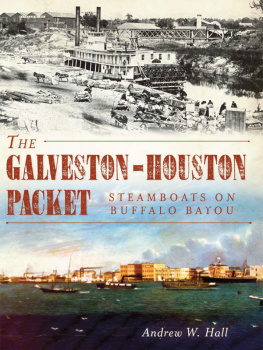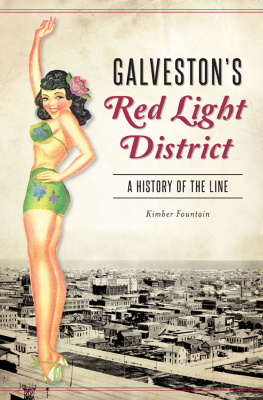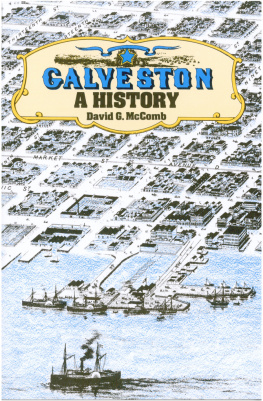
Published by The History Press
Charleston, SC 29403
www.historypress.net
Copyright 2012 by Andrew W. Hall
All rights reserved
Front cover, top: Sternwheel packet St. Clair at the Houston landing, circa 1867. Houston Metropolitan Research Center, Houston Public Library /San Jacinto Museum of History. Front cover, bottom: Detail of William Aiken Walkers 1874 depiction of Galveston harbor, showing (left background) a Buffalo Bayou packet, possibly Diana, and (center) a cotton barge being towed by a steam tug. Galveston and Texas History Center, Rosenberg Library, Galveston.
First published 2012
e-book edition 2012
Manufactured in the United States
ISBN 978.1.61423.749.5
Library of Congress CIP data applied for.
print ISBN 978.1.60949.591.6
Notice: The information in this book is true and complete to the best of our knowledge. It is offered without guarantee on the part of the author or The History Press. The author and The History Press disclaim all liability in connection with the use of this book.
All rights reserved. No part of this book may be reproduced or transmitted in any form whatsoever without prior written permission from the publisher except in the case of brief quotations embodied in critical articles and reviews.
For Becki, Faith and Emily Faith
CONTENTS
ACKNOWLED GEMENTS
This volume had its genesis more than twenty years ago when I was on the staff of the Texas Maritime Museum in Rockport. My friend and colleague Jerry W. Moore and I developed an exhibit on Texas steamboats. The exhibit idea got a little out of hand before it was all doneit included a full-scale mockup of a steamboat pilothouse, complete with an eight-foot-diameter wheel and working bell signalsbut it was hells own fun pulling it all together. Though Id grown up on the Texas coast, in a town that owed much of its early development to inland steam navigation, it was a story that had not often been told. I was hooked.
Two public archives have proved to be invaluable in doing the research reflected in this volume. The Houston Metropolitan Research Center at the Houston Public Library provided many of the materials upon which the initial research was based, including vertical file clippings and images, several of which appear in this work. Archivist Doug Weiskopf, in particular, provided considerable and eager assistance, tracking down half-remembered image collections and obscure references. Dougs own specialty is historic railroads, so its hard to know if his enthusiasm about Buffalo Bayou steamboats was real or feigned, but either way, it helped propel some of my initial research, and so is to be greatly appreciated.
The other crucial archival source, naturally, is the Galveston and Texas History Center at Rosenberg Library in Galveston. The folks there have been consistently helpful and supportive of this project and willing to make extra effort in locating sources. In addition to Head of Special Collections Casey Greene, other Rosenberg staffers who have assisted with this project include Carol Wood, Mary Magdalena Hernandez, Jenna deGraffenried, Julia Dunn, Shelly Kelly and Anna Peebler. The Galveston and Texas History Center stands as one of the preeminent historical archives in the state, and it has been my great fortune to have such a resource to guide me in this and other areas of research.
In addition to archival research, much of my understanding and appreciation of inland steam navigation has come from close examination and investigation of actual steamboat wrecks from the period. Almost all of the boats discussed in this volume are considered to be of the Western Rivers type, a distinctly American class of steam vessel whose design and operation was uniquely suited to the conditions of the rivers in the West, as it was understood in the early nineteenth century, encompassing the Ohio, Mississippi and Missouri Rivers and their tributaries.
Through affiliation with the Texas Historical Commission, the Institute of Nautical Archaeology, the PAST Foundation and the Southwest Underwater Archaeology Society, Ive had the opportunity to visit, record and help interpret steamboat wrecks dating as far back as the 1830s, spanning Texas from the Rio Grande to the Sabine to the Red River. Two of these boatsA.S. Ruthven and Mary Conleythemselves ran on Buffalo Bayou during their active careers. I was fortunate, as well, to be part of the team from the PAST Foundation that was first to examine the Red River wreck later identified as Heroine, one of the earliest examples of a Western Rivers steamboat. This practical, hands-on experience has given me a greater appreciation for the way the boats were built, how they operated and the hazards they faced.
In this fieldwork, Ive benefited tremendously from three persons, in particular, who each in succession held the position of state marine archaeologist with the Texas Historical Commission: Barto Arnold, Steve Hoyt and Amy Borgens. Each of these three has offered resources, answered questions and generally helped shape my understanding of the subject. With as much as they have helped my own work, I hope that Ive been able to contribute to their work at least a little bit.
Many other individuals have provided assistance and encouragement along the way. These include the late Pam Puryear of Navasota, the late Captain Alan L. Bates of Louisville, Captain Lexi Palmore, Layne Hedrick, Tom Oertling, Randy Jones, Laura Landry, Jim Hauser, Annalies Corbin and Sheli O. Smith. In particular, I want to thank my friend Edward T. Cotham Jr., author of Battle on the Bay: The Civil War Struggle for Galveston and other works, for his persistent encouragement and well-considered guidance. Ed was good enough to read parts of the manuscript and make critical corrections, for which I am truly grateful. My fellow Civil War blogger and author James M. Schmidt has been a valuable sounding board for this work, based both on his experience as an author and his knowledge of Galveston in the mid-nineteenth century. Jim also helped review parts of the manuscript, which I appreciate greatly.
Finally, this work would not exist without the patience and guidance of my editors at The History Press, Becky LeJeune and Darcy Mahan. They and the rest of the staff at The History Press provided encouragement, guidance and the benefit of their experience through this process. They make me look good.

Supplemental materials, including technical background on the steamboats that ran on Buffalo Bayou, may be found at the authors website:
www.maritimetexas.net.
Chapter 1
ARROYO CIBOLO
There was no romance in these stories.
Historian Keith Guthrie, describing the hazards of navigation on Galveston Bay
The influx of Anglo-American settlers into Texas, which began in the 1820s and continued through the late nineteenth century, brought about fundamental change in the settlement and migration patterns of the region. Central to this new arrangement were the rivers that crossed the eastern half of the territory, particularly the Brazos and Colorado Rivers and Buffalo Bayou. These waterways both shaped and were shaped by the new Texians, as the people began to call themselves, changing both the cultural and physical geography of the region.
The Spanish rulers of Texas, and the Mexican governments that succeeded them from 1821, did not view rivers in the same way that the Americans would later. The Spanish settlements and outposts, largely confined to the southern and western parts of the region, did not rely significantly on waterways for the transport of people, and failed to establish a port of any significance along what is now the Texas coast.
Next page








